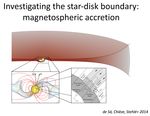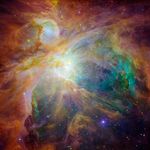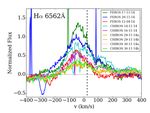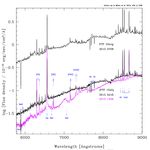The Young and the Restless Stars in the Time Domain - Lynne A. Hillenbrand (Caltech) - Cosmos
←
→
Page content transcription
If your browser does not render page correctly, please read the page content below
The Orion Nebula Cluster of Young
Stars in Infrared and Optical Light
Megeath et al. 2008 Robberto et al. 2006Disk Formation, Accretion, Evolution
later, viscous evolution and photo-evaporation
early accretion
(and outflow)
Bae et al. (2014) Alexander (2014)Zooming in to the Disk-Magnetosphere-Star Zone
Infalling accretion
column
Chromosphere
Preshock
pre-shock
X-rays
Shock
X-rays
post-shock Stellar
photosphere
Photosphere heated
photosphere
de Sa et al. 2014 Calvet & Gullbring 1998Observable Consequences of Magnetospheric Accretion
Increasing accretion rate
Barensten et al. 2013
Hartmann, Herczeg, Calvet 2016Innermost disk regions (r < 0.05 AU)
• Dynamical time at the co-rotation radius ~1 week
• Infall time along magnetic field lines ~hours
both
accretion
• and ejection
of material
Kurosawa,
RomanovaKurosawa, Romanova
Young Star Variability
• Mechanisms include:
• possible pulsation phenomena
• time variable magnetic activity on star stellar
• rotation of stellar surface inhomogeneities e.g.
cool or hot spots
• time variable accretion from disk to star
• disk inhomogeneities e.g. orbiting warps or disk-related
vertical circulation
• binary phenomena. companion
• Amplitudes range from 5 mag,
typically 0.1-0.2 mag.
• Time scales range from hours to years, typically
0.5-2 days.A Range of Observing Strategies is Needed
• High precision
• Underlying stellar processes e.g. pulsations, spots, rotation
CoRoT
• Details of accretion-driven and extinction-driven behavior
+
K2 • High cadence
• Resolve the time scales for accretion and/or inner disk geometry changes
PTF/ZTF
+
• Long duration (can be lower precision)
Gaia • Probe more dramatic accretion and disk morphology history
• Multiwavelength
Spitzer
• Importance of dust extinction vs gas accretion processes
+
NEOWISE • Importance of radiative vs dynamic processesThe Quality of Modern Data is Outstanding !
Ten to Fifteen years ago:
• ground-based
• precision-limited
• cadence-limited
• many gaps
Today:
• space-based
• exquisite precision
• excellent cadence
• acceptable gapsVariable Photometry:
Accretion-Driven Behavior
14% of the objects with disks exhibit with these types of lightcurves [Cody et al. 2017]Small and Moderate-Amplitude Bursters in PTF [Findeisen et al. 2013]
A Large, Short-lived Burst
Increase in disk accretion rate caused
~3 mag brightening for several months
accompanied by enhanced spectral
veiling. PTF15afq
Miller et al. (2015)A Somewhat Larger, Somewhat Longer-Lived,
But Still Temporary BurstInnermost Disk Instabilities
magnetospheric instability e.g. Goodson & Winglee (1999)Extreme Outbursts = FU Ori Stars
Broader Disk Instabilities
classical thermal instability driven by change in kappa e.g. Bell & Lin (1994)
Armitage (2010)Broader Disk Instabilities
- Magneto-rotational instability, driven by
- change in ionization e.g. Balbus & Hawley (1991)
- change in alpha e.g. Zhu et al
- Gravitational instability driven by accumulation of mass
è Gravo-magneto instability studied by Martin & Lubow (2011) Armitage (2010)The First Three
Witnessing an FU Ori Outburst
Miller et al. (2011)
PTF10qpf
=
LkHa 188/G4
=
HBC 722
=
V 2493 CygPTF10qpf
=
LkHa 188/G4
=
HBC 722
=
V 2493 Cyg
Semkov et al. (2017)A Pre-Outburst Spectrum!
The FU Ori
previously
was a typical
M3 type
classical
T Tauri star
with Halpha
emission.A Gaia-Discovered FU Ori Star
Gaia 17bpi
2004 2010 2014 (in a relatively unstudied dark cloud)
Hillenbrand et al. (2018)Yet Another Likely Recent FU Ori Event
Hillenbrand et al. (2019) PTF14jg
(near W4 HII region)An Unusually Hot FU Ori Outburst ? As PTF 14jg faded, Li I 6707 Fiducial Tmax became more for a classical accretion disk obvious. surrounding a young star: Hillenbrand et al. (2019)
Extreme Outbursts – How Frequent?
Vorobyov 2006Extreme Outbursts – How Frequent?
• Although we appear to be
getting better at noticing
outbursting young stars,
undoubtedly, we are not
finding them all.
• In order to estimate the
outburst rate – as distinct from
the detection rate -- we need
to understand our efficiency
(or better stated, inefficiency).
• Rate estimation is difficult
without more complete young
star census information.Compare to the Even More Intrinsically Rare
Tidal Disruption Events
Theory:
~10-5 to 10-4 / year / galaxy
Current Census:
~45
plot from S. GezariConstraining the Rate of FU Orionis Outburst Events Need to know the numerator. Need to know the denominator. Need to have enough stars for meaningful statistics! Hillenbrand and Findeisen (2015)
Scheme of a disk structure
Text
• < 1000 AU, ~ 0.1 – 10% M , 1 – 10 Myr
*
• Gradients of T, n, dust properties
20 AU 2 AU 0.03 AU • UV, X-rays, CRP
• Dynamics
Semenov
Henning & Henning
& Semenov 2014, Chem. Reviews, submitted[McJunkin et al. 2013]
What is the Geometry of the Circumstellar Dust?
``Dippers” from Ground-Based Data (CTIO) [Cody and Hillenbrand 2011]
Narrow Fades, a.k.a. ``Dippers” from CoRoT in NGC 2264
[Stauffer et al. 2015]
[Venuti et al. 2017]``Dippers” from K2 in Upper Sco
Quasi-periodic Examples
Aperiodic Examples
Cody and Hillenbrand (2018)
[see also Ansdell 2016 and Hedges 2018]Viewing Angle Sets Line-of-Sight Opacity
• Dust blocks light from star / inner disk when viewed at high inclination
• Consider inhomogenous (i.e. clumpy) disk or radially structured disk
[Dullemond]
[Bertout 2000]Increasing disk inclination
Inclination Effects in Upper Sco
Low Inclination = Bursters, Stochastics
High Inclination = Aperiodic Dippers (2 exceptions)
Quasi-periodic Dippers
Quasi-periodic Symmetric
Disk sizes similar among the lightcurve categories
Cody and Hillenbrand (2018)Moderate Amplitude Faders in PTF [Findeisen et al. 2013]
Likely A Continuum of Faders Too
deep
depressions
lasting months
shallow
depressions
lasting yearsEXTREME
EXTINCTION
Long-duration fades of 5-7 mag!
Catching this repeating
cycle in a rising part of
the phase might cause
incorrect interpretation
as an outburst event.
(see Gaia data points)K2 Study in rho Oph and Upper Sco
Cody and Hillenbrand (2018)
Nearly 1500 objects observed in K2/C2 programs towards the 1-3 Myr rho Ophiuchus and 5-10 Myr
Upper Scorpius regions.
Membership vetting via color-magnitude diagrams and proper motions.
WISE and Spitzer used to identify those with infrared excess indicative of primordial circumstellar
disks.
Variability properties of 288 young disk-bearing stars from B through M spectral types, 96% of
which are identified as photometrically variable.
Variability classes include: ``dippers'' (fading events), ``bursters'' (brightening events), and
``symmetrics'’, each ranging from stochastic, to quasi-periodic to periodic types.
Bursters, stochastic sources, and the largest amplitude quasi-periodic stars have larger infrared
colors, and hence stronger circumstellar disks. They also tend to have larger Halpha equivalent
widths, indicative of higher accretion rates. They favor low inclinations, i < 50-60 deg.
Dippers, on the other hand, cluster toward moderate infrared colors and low Halpha. They favor
high inclinations, i > 50 deg, apart from a few notable exceptions with close to face-on disks.7% 5%
26% 14%
16% 17%
8% 3%
Cody and Hillenbrand (2018)Quantifying Lightcurve Symmetry
bursting symmetric dipping
Cody et al. (2014)Quantifying Degree of Periodicity
periodic quasi-periodic aperiodic
Cody et al. (2014)Lightcurve
Mophology
Classification
of Rho Oph
and
Upper Sco
Disk-Bearing
Stars
Cody and Hillenbrand (2018)Time Scales and Amplitudes
300% Long = Bursters, Stochastics
Aperiodic Dippers
Int = Quasi-periodic Dippers
Quasi-periodic Symm.
10%
Short = Periodic
Multi-Periodic
Amplitude ranges of most
disk categories are similar.
day week month
0.1%
Cody and Hillenbrand (2018)Stars can change their variability patterns
on few year time scales !!
quasi-periodic dipper è irregular
aperiodic è periodic spot-like
[McGinnis et al. 2015]2008 2011 2008 2011 Stars can
change their
variability
patterns on few
year time
scales !!
aperiodic è quasi-periodic,
but not all spot-like
[Venuti et al. 2017]You can also read



























































